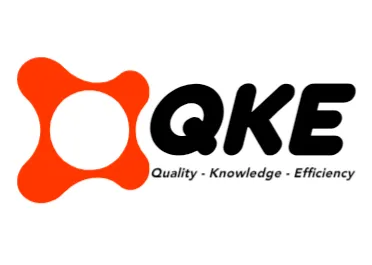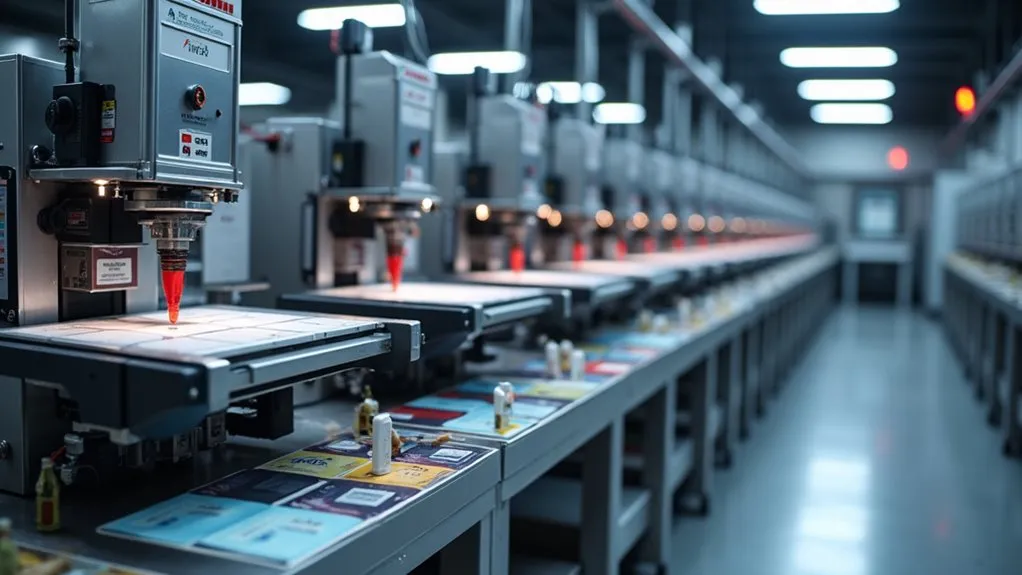Choosing the optimal flat surface labeling machine for your business requires careful consideration of labeling requirements, including surface characteristics, label size, and material compatibility. Trends indicate a growing preference for pressure-sensitive labels, emphasizing the need for precise label placement to ensure production efficiency and quality. This guide explores top flat surface labeling machines, including the Primera AP550, Flex+Matic® Label Applicator, and ZONESUN ZS-TB851, providing insights into their features, benefits, and how they can be integrated into various production environments to enhance performance.
Key Points to Remember
- Consider the labeling machine’s capacity and compatibility with various label sizes and materials for business needs
- Evaluate production output and speed to select the appropriate labeling machinery
- Compact, versatile designs save space and provide mobility for flexible business operations
- Advanced features like vision systems and automation enhance efficiency and product quality
- Choose scalable technology that integrates with existing systems for future growth
Understanding Your Labeling Needs
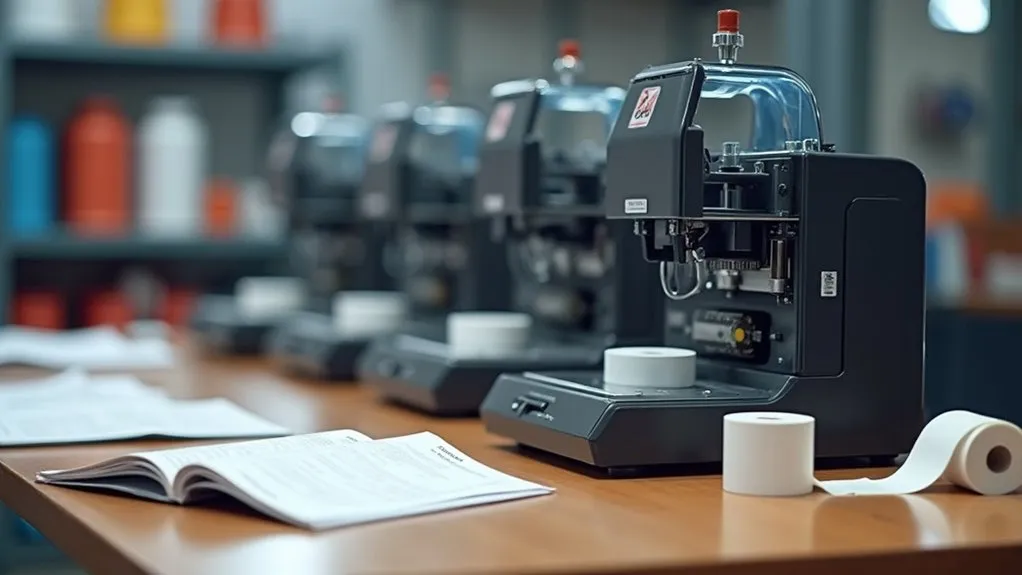
Understanding your business’s labeling needs is critical when selecting the right flat surface labeling machine. This involves identifying challenges such as product surface characteristics, label dimensions, and material compatibility.
Labeling trends, including the increasing use of pressure-sensitive labels, must be considered to ensure the machine meets current and future requirements. Precise label placement is essential, with various application methods such as tamp, air-blow, and wipe-on depending on the product and production speed. Additionally, high-speed models can apply up to 30,000 labels per hour, significantly improving operational efficiency.
Evaluating production volume and speed requirements will determine whether a manual, semi-automatic, or fully automatic labeling machine is most suitable, taking into account future growth and scalability needs.
In-Depth Evaluation of Primera AP550
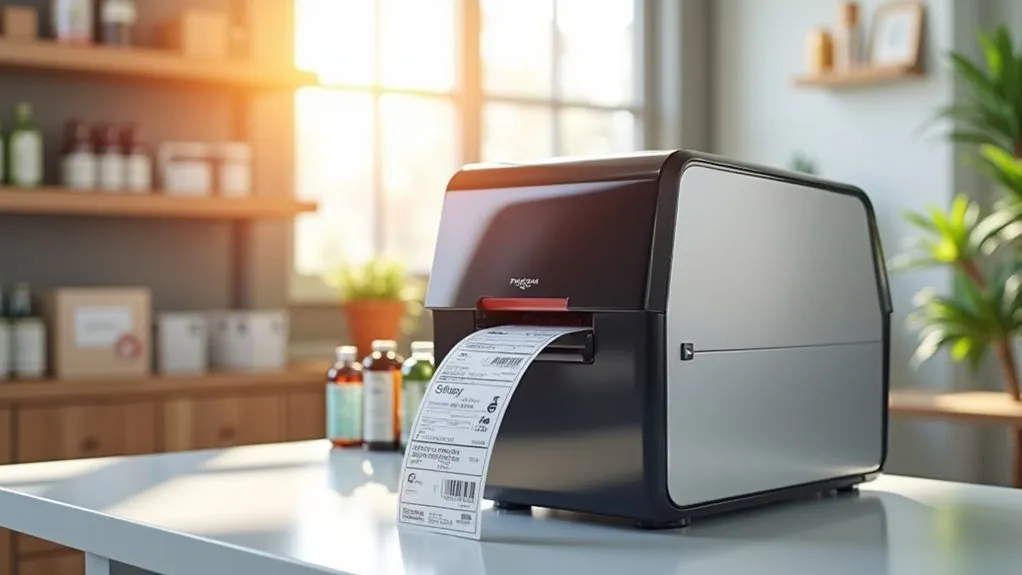
The Primera AP550 labeling machine offers key features that enhance labeling efficiency for flat and tapered surfaces, such as semi-automatic operation and the ability to apply wrinkle-free or fold-free labels.
Its performance is marked by a labeling speed of up to 500 units per hour, delivering precise and professional label application.
The user experience is enriched by the machine’s simple operation, including placing the container in the mechanism and pulling a lever for automatic labeling, along with a compact footprint and durable construction. Additionally, the Primera AP550 exemplifies the importance of versatile labeling solutions by meeting diverse labeling requirements across multiple industries.
Key Features Revealed
The Primera AP550 labeling machine is a versatile and user-friendly device designed for businesses seeking efficient labeling for various flat-surface Containers.
Key features include:
- Compatibility with various container shapes: Applies labels to different shapes and sizes of containers, from rectangular boxes to tapered bottles, accommodating heights from 0.05 mm to 203 mm.
- Support for multiple label types: Works with various label types and sizes, supporting widths from 19 mm to 101.6 mm and heights from 19 mm to 152.4 mm, including transparent labels with proper marking.
- User-friendly design: Features a simple semi-automatic operation design, with an LED display for monitoring, quick setup, and no need for external air supply.
- Smart features and memory: Includes an optical sensor for label detection, memory for up to nine jobs, and precise label placement adjustments.
Performance and Accuracy
As businesses demand higher performance in the labeling process, the Primera AP550 stands out with its combination of speed and meticulous accuracy. This labeling device integrates advanced labeling technology to enhance workflow, capable of applying up to 500 labels per hour with a rapid application speed of 5.3 inches per second. Its design ensures wrinkle-free labeling, utilizing an optical sensor for label gap detection and a micro-switch for activation, resulting in consistent and precise label application.
| Feature | Specification |
|---|---|
| Label Application | Up to 500/hour |
| Label Speed | 5.3 in/second |
| Accuracy Features | Optical Sensor, Micro-Switch |
User Experience Insights
Shifting focus to user experience, the Primera AP550 labeling machine is designed with the operator in mind, ensuring easy setup and intuitive daily operation.
User feedback highlights the following insights:
- Quick assembly with guided setup instructions.
- Simple manual action to apply labels with the pull of a handle.
- Versatile material handling for various flat and tapered surfaces.
- Integrated LED display with job memory settings to enhance efficiency.
Operational challenges are minimal, though users note the potential need for lift bases or custom frames to label thin or irregular items.
Flex+Matic® Labeler: Efficiency Redefined
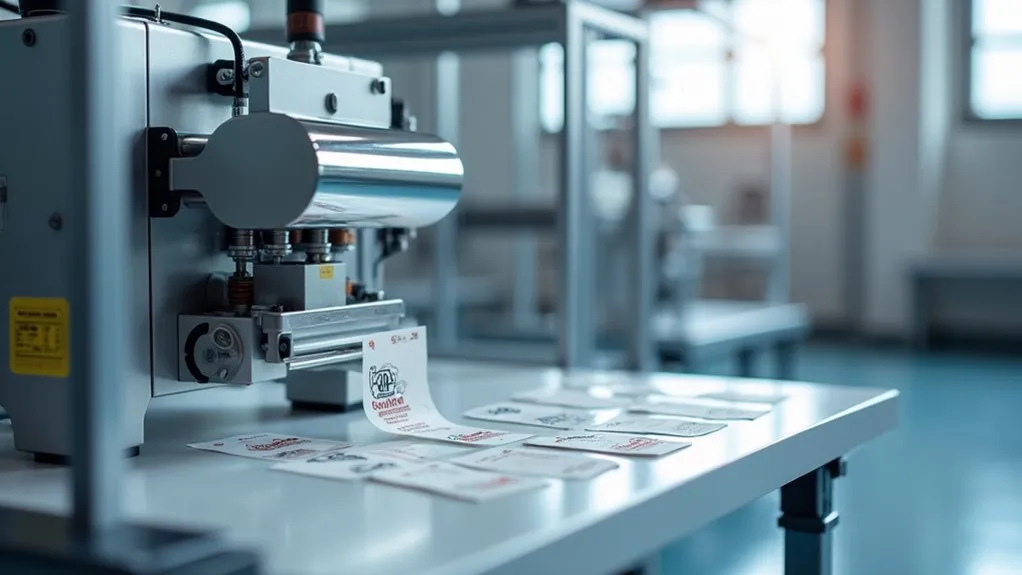
The Flex+Matic® labeling machine sets a new standard for labeling efficiency, combining high-speed operation with precise label placement.
This machine is designed to accommodate a wide range of flat items, adapting to various materials and sizes while maintaining consistent accuracy.
Its construction, featuring a laser-cut steel frame and aluminum dispensing table, ensures durability and reliability in demanding industrial environments. Additionally, it optimizes label placement for improved scanning efficiency, enhancing overall productivity in labeling operations.
Speed and Accuracy
With an emphasis on efficiency, the Flex+Matic® labeling machine delivers high-speed operation combined with superior accuracy, making it an ideal choice for businesses requiring rapid and precise labeling on flat surfaces.
This labeling machine showcases the latest labeling technology and aligns with current automation trends, ensuring businesses can maintain a competitive edge.
- High-speed operation: Capable of labeling over 1,200 pieces per hour with a feed speed of 5 inches per second, it ensures most items are labeled in under 2 seconds, optimizing production time.
- Precision and accuracy: Maintains vertical placement within 1/16 inch and horizontal accuracy within 1/64 inch, critical for industries where precision is paramount.
- User-friendly adjustments: Features like a digital display for vertical position settings and a non-adjustable optical sensor simplify operation and adjustments, enhancing user experience.
- Design and build: Constructed with a laser-cut steel frame and polished aluminum dispensing table, it is built for durability and efficiency, reducing downtime and maintenance costs.
Diverse Application Range
Expanding the capabilities of the Flex+Matic® labeling machine, its diverse application range further underscores its value across various industries.
This machine excels in labeling techniques for a wide range of items, including pouches, envelopes, bags, and PCBs, demonstrating its utility in packaging, electronics, and mailing sectors.
With the ability to handle items up to 1/4 inch thick and a labeling width of 11 3/4 inches, it accommodates die-cut labels, paper, synthetic plastics, and even transparent labels.
The Flex+Matic® labeling machine’s operational adjustments and rapid label roll loading enhance its adaptability across various flat packaged goods, making it an indispensable tool for improving productivity and efficiency in the labeling process.
ZONESUN ZS-TB851: Automation Capabilities
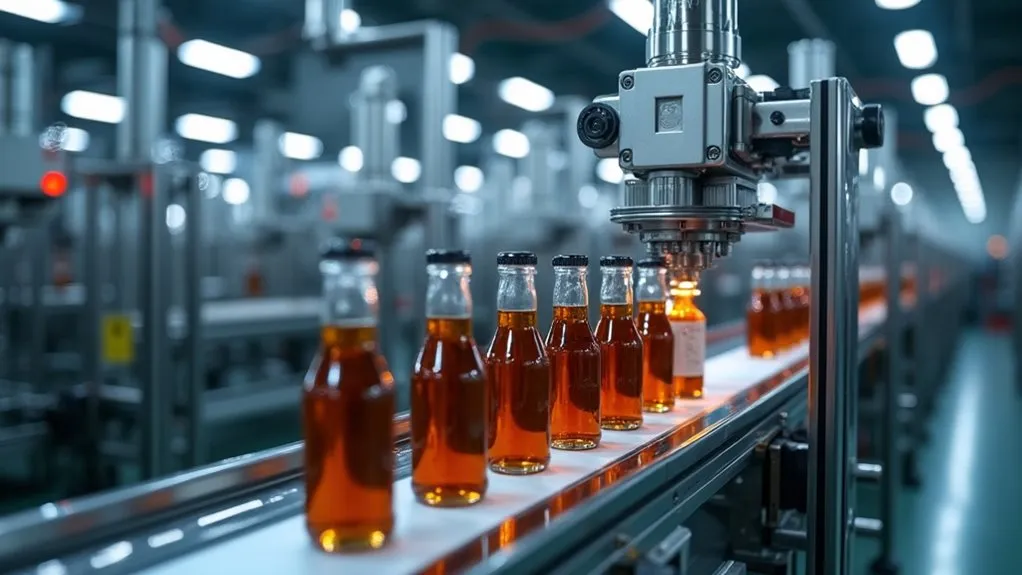
Automation prowess is exemplified by the ZONESUN ZS-TB851, a sophisticated flat surface labeling machine designed to meet the stringent demands of modern production lines.
Demonstrating excellence in automation, the ZONESUN ZS-TB851 flat surface labeling machine sets a new standard for precision and efficiency in modern production environments.
This machine excels in:
- Automated labeling: The ZS-TB851 fully automates the labeling process, significantly reducing manual labor and increasing production speed.
- Sensor technology: Integrated sensors detect products and trigger precise label application, ensuring accuracy within ±1mm.
- Control system: An advanced system adeptly manages labeling timing and placement, compatible with product sizes ranging from 10-150mm.
- Industrial design: Built for durability, it supports continuous operation in industries such as food and beverage, cosmetics, and pharmaceuticals. Additionally, it benefits from dynamic weight checking to ensure products meet quality standards before labeling.
LabelOn™ Benchtop Models: Compact Solution

LabelOn™ Benchtop Models offer a compact design suitable for businesses with limited space, providing a cost-effective solution for small to medium production needs.
These models are ideal for labeling flat and near-flat surfaces of various products, including boxes, bags, and sheets, with high precision and efficiency.
The machines’ customizable features and settings allow flexibility in handling different product sizes and labeling requirements, making them a versatile choice for multiple industries.
Advantages of Compact Design
The compact design is the cornerstone of LabelOn™ Benchtop Models, offering significant advantages for businesses looking to optimize space without compromising labeling efficiency.
These models are designed to:
- Save floor space with a compact footprint suitable for retail, workshops, and laboratories.
- Offer high versatility through integration into existing lines or operation as standalone units.
- Provide a cost-effective solution by reducing the need for larger, more expensive equipment.
- Enhance operational efficiency with quick setup, user-friendly interfaces, and minimal training requirements.
The mobility benefits of these compact designs allow flexible placement and easy transport between locations, making them ideal for diverse production environments and on-demand labeling needs.
Ideal Application Scenarios
Beyond space and operational efficiency due to the compact design of LabelOn™ Benchtop Models, their versatility shines in various application scenarios.
These machines seamlessly transition businesses from manual to semi-automatic labeling, aligning with industry trends toward more efficient and consistent labeling processes. They are particularly suited for the food and beverage industry, where precise label placement on items like trays, bags, and jars is essential for branding and regulatory compliance.
Additionally, in the cosmetics and personal care industry, these labeling machines ensure a professional appearance across various packaging types, from flat bottles to oval containers, meeting the industry’s high aesthetic standards.
Their adaptability makes them key players in contemporary labeling innovations across multiple industries.
Customization and Flexibility
LabelOn™ Benchtop Models embody the spirit of customization and flexibility, offering compact solutions tailored to diverse labeling needs. These models provide multiple customization options and flexibility benefits to accommodate various product shapes and sizes.
- Diverse Container and Shapes: Handle round, oval, and flat containers with configurable settings for different product diameters.
- Label Placement Adjustability: Suitable for single-sided, double-sided, and full-wrap labeling with precise positioning controls.
- Operational and Control Flexibility: Integrate PLC controllers and user-friendly touchscreens, enabling quick transitions between container sizes and shapes.
- Physical and Mechanical Customization: Feature a compact size without compromising durability or functionality, including options for taller labeling heads and larger-capacity label roll holders.
VEVOR Electric Flat Labeler: Versatile and Fast
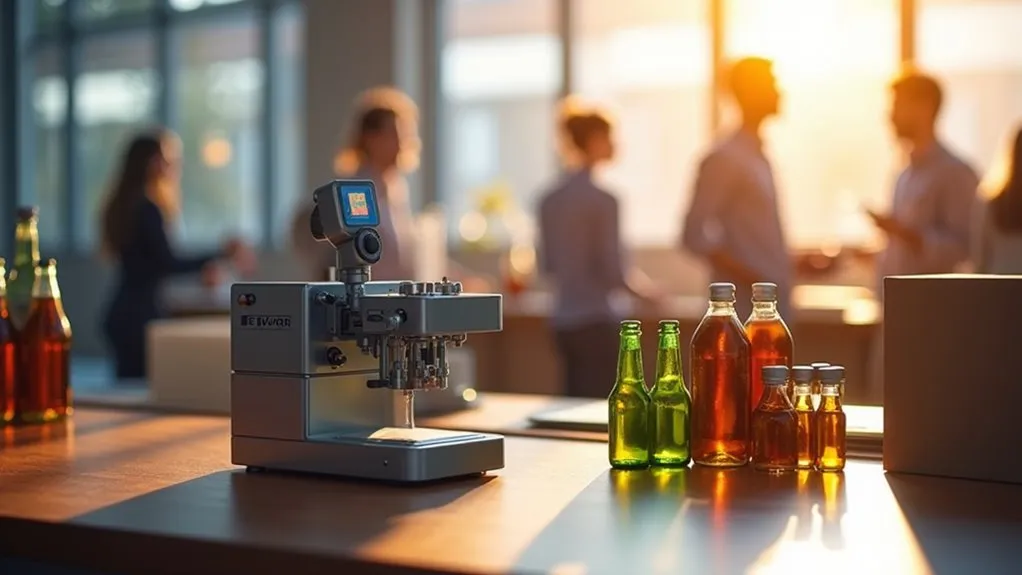
The VEVOR Electric Flat Labeler is a versatile and efficient tool designed for businesses requiring rapid and accurate labeling on various flat surfaces.
Capable of applying 25-60 labels per minute, the machine tackles labeling challenges with a high-powered motor and intelligent optical sensors to minimize errors and enhance accuracy.
It ensures label durability through smooth, wrinkle-free, bubble-free, and edge-curl-free application, suitable for paper boxes, cartons, and tin cans in the food, beverage, and cosmetics industries.
Ensuring flawless label application, the machine excels in durability and precision, perfect for multiple industries including food, beverage, and cosmetics.
Its durable aluminum alloy construction provides rust resistance and long-term use, with an adjustable label disc for personalized label width, making it a comprehensive solution for diverse labeling needs.
Manual vs. Semi-Automatic vs. Fully Automatic: Right-Sizing
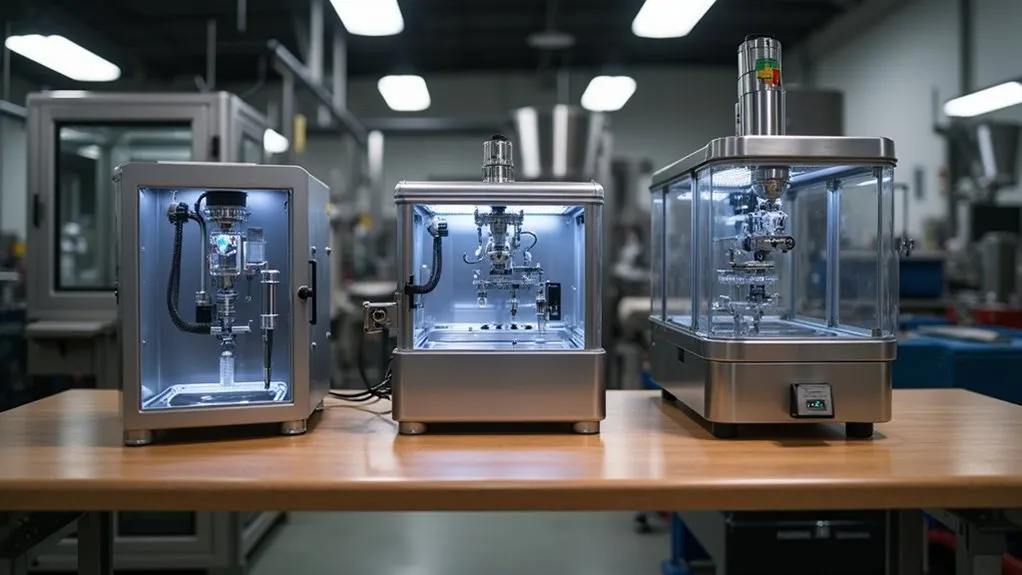
When considering labeling solutions for your business, understanding the distinctions between manual, semi-automatic, and fully automatic labeling machines is crucial.
Each type of labeling technology offers different levels of automation benefits:
- Manual Labeling Machines: Ideal for entry-level needs, these are cost-effective solutions for low-volume operations but require more labor and have slower speeds.
- Semi-Automatic Labeling Machines: A middle-ground option, they enhance efficiency with moderate investment, suitable for growing businesses.
- Fully Automatic Labeling Machines: Best for high-volume production, they offer the highest speed and efficiency with advanced features, requiring a higher initial investment.
- Right-Sizing Choice: Evaluate production volume, growth forecasts, and labor costs to select the most suitable labeling technology.
Key Features to Look for When Choosing a Flat Surface Labeler
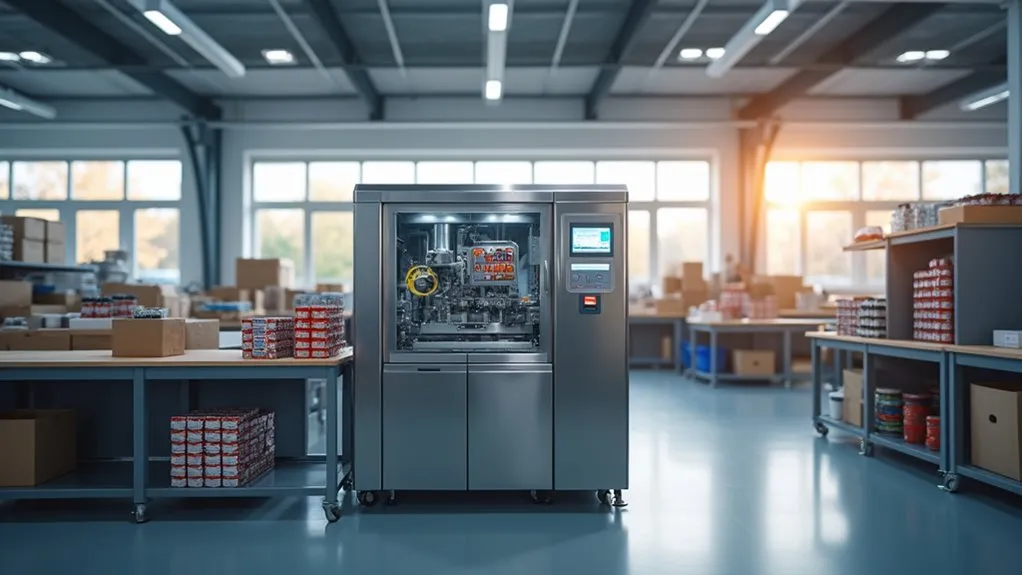
When selecting a flat surface labeling machine for your business, several key features should be considered.
Labeling technology is critical, with models offering high precision of ±0.5mm to ±1mm, ensuring consistent label placement.
Product compatibility is essential; machines should handle a wide range of flat-surfaced items and materials, including plastic, glass, and cardboard.
The machine should adapt to various label sizes and types, including transparent labels.
Operational features like user-friendly touchscreen interfaces, reliable label detection sensors, and adjustability for different product sizes are vital for efficient operation.
Construction materials should meet GMP standards, and the labeling machine should easily integrate into existing production lines.
Cost and Benefit Analysis of Labeling Automation
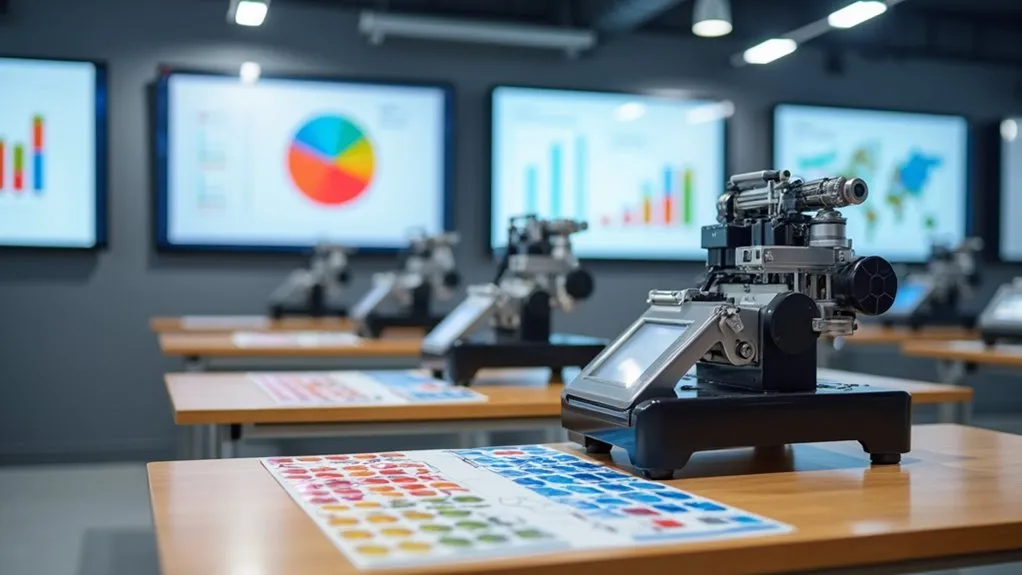
A cost versus benefit analysis of labeling automation reveals a compelling case for adopting this technology across various industries. A comprehensive cost analysis coupled with a thorough benefit assessment shows that despite the initial investment, the long-term financial advantages are significant.
Key factors include:
- Return on Investment (ROI): Many businesses witness rapid ROI, often within a year, stemming from higher efficiency and reduced costs.
- Reduced Labor Costs: Decreasing reliance on manual labor allows workforce reallocation to more critical tasks, enhancing productivity.
- Lower Operational Costs: Automated systems reduce recurring costs associated with manual labeling, such as wages, training, and benefits.
- Predictable Budgeting: Automation in place leads to more stable long-term costs, facilitating financial planning.
Integrating Labeling Solutions into Your Production Line
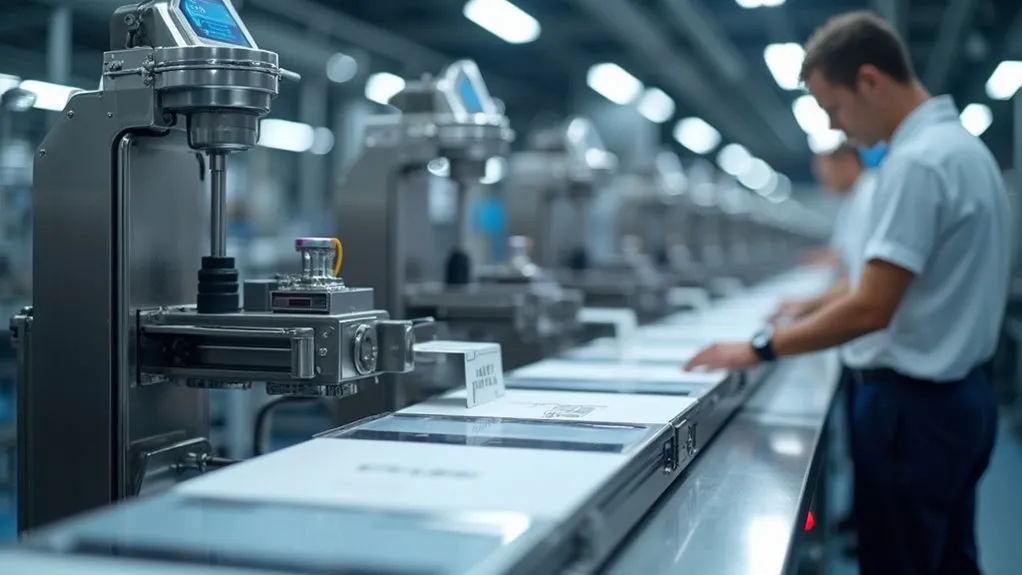
Integrating labeling solutions into your production line requires a meticulous approach to ensure seamless operation and optimal results.
Begin with a comprehensive pre-integration assessment to understand physical and operational constraints. Choose scalable and compatible technology to enhance production performance through intelligent features like vision systems for quality control.
Data integration with ERP or WMS systems eliminates manual data entry, minimizing errors and improving accuracy. Efficient label placement on the production line ensures synchronization with conveyor systems.
Post-integration, continuously monitor the system to address inefficiencies and consider emerging technologies like AI for predictive maintenance.
This holistic approach ensures that labeling automation significantly boosts production performance.

 Tiếng Việt
Tiếng Việt 日本語
日本語 中文 (中国)
中文 (中国) 한국어
한국어